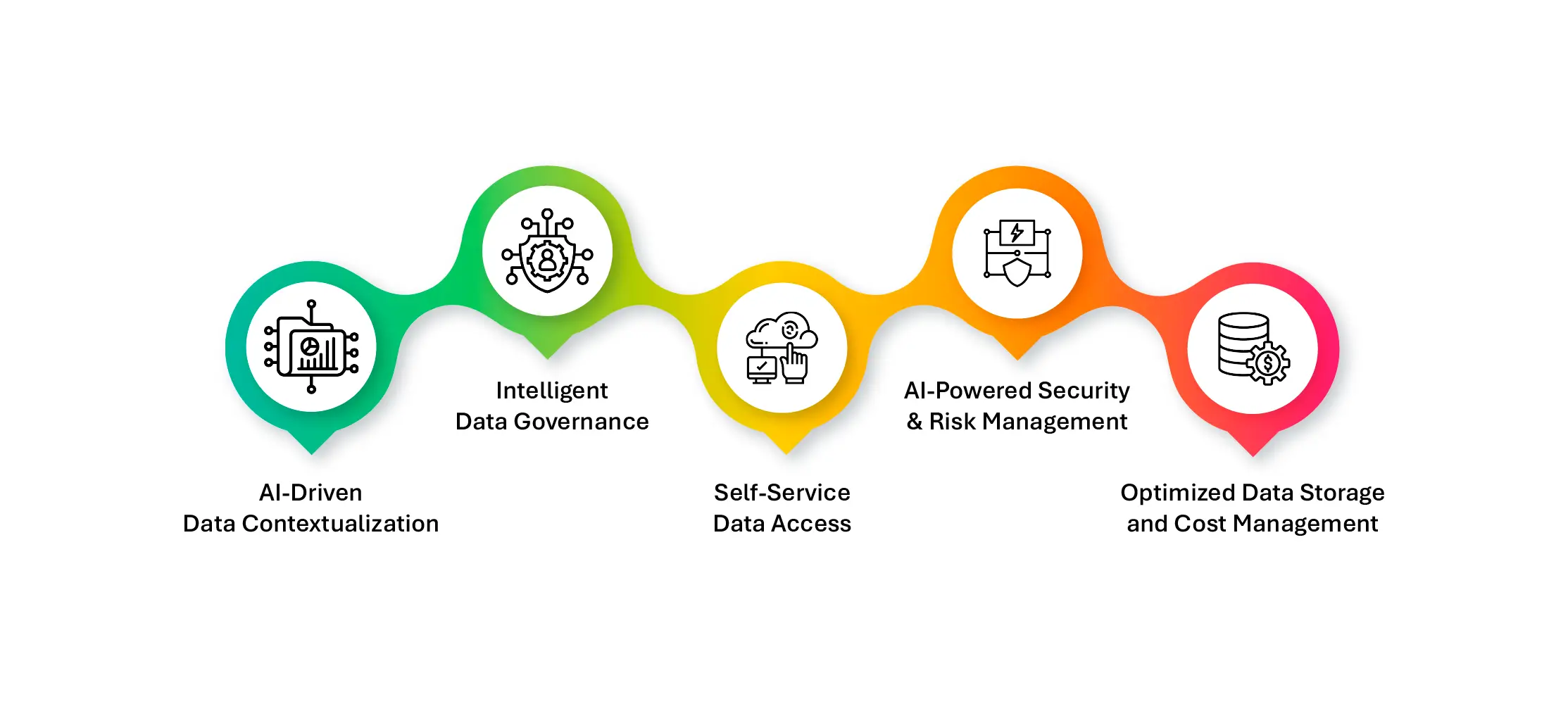The Unstructured Data Crisis: A Billion-Dollar Problem
If data is the new oil, then unstructured data is its crude form—vast, untapped, and brimming with potential. But like crude oil, unless refined, it is more of a liability than an asset.
Across regions investing heavily in AI and digital transformation, enterprises are executing multi-billion-dollar strategies to establish themselves as leaders in the global AI economy. Governments and businesses alike are embedding AI-driven decision-making into their strategic frameworks, ensuring that innovation remains a key driver of economic progress. In regions such as the Middle East, where national visions prioritize digital economies, data governance and security have become essential pillars of transformation.
However, despite massive investments, enterprises face a paradox:
- AI is only as powerful as the data it ingests—yet businesses are drowning in an unstructured data tsunami, limiting AI’s full potential.
- Data should fuel innovation—yet, in its raw, fragmented state, it is turning into a liability.
Unstructured data—emails, chat logs, financial transactions, IoT sensor feeds, and medical records—is fast becoming a ticking time bomb. Security vulnerabilities, regulatory compliance challenges, and operational inefficiencies are compounding the issue.
CISOs see the risk. So do CIOs. Yet, the biggest issue? They are tackling it in isolation instead of collaborating.
The Unseen Risk: When Data Becomes a Liability
Unstructured data isn’t just a storage challenge. It is an existential business risk. If left unmanaged, it:
🔹 Exposes Enterprises to Cyber Threats
- In 2023, the AvosLocker ransomware group attacked a major hospital, encrypting 60GB of critical patient and insurance records. The breach disrupted essential medical services, compromised patient confidentiality, and damaged institutional trust.
- The global average cost of a data breach in 2024 was USD 4.88M —a 10% increase over last year and the highest total ever.
🔹 Weakens AI Models with Poor Data Quality
- Studies on AI in healthcare have revealed that incomplete or misclassified unstructured data degrades AI models, leading to biased or inaccurate predictions.
- 30% of AI models fail due to poor data quality, limiting their effectiveness in decision-making and compliance monitoring.
🔹 Triggers Regulatory Crackdowns
Governments are responding with stringent regulations to strengthen data privacy, security, and governance. In markets with stringent data protection laws, such as Saudi Arabia’s Personal Data Protection Law (PDPL) and the UAE’s Federal Data Protection Law, businesses must navigate data localization requirements and compliance frameworks. However, compliance alone is insufficient. Storing unstructured data in localized centers does not make it secure or actionable. The real challenge is transforming unstructured data into a compliant, AI-ready, business-intelligent asset.
CIOs vs. CISOs: The Divide Holding Back Data-Driven Transformation
At first glance, CIOs and CISOs share a common goal: securing and maximizing the value of enterprise data. But in practice, they operate in silos.
- CIOs manage IT infrastructure and focus on the “where” of data storage.
- CISOs oversee security, compliance, and governance—the “how” of data protection.
This disconnect leaves enterprises vulnerable to inefficiencies, compliance risks, and millions in missed AI-driven opportunities.
Why This Matters Now
- Data silos cost enterprises an average of $12.9 million annually (Gartner, 2024).
- AI-led businesses that unify security, governance, and storage are outperforming their peers by 3X in efficiency and innovation (IDC, 2023).
A new approach is needed—one that unites CIOs and CISOs under a common strategy: Data Synergy.
From Chaos to Clarity: The Data Synergy Framework

The Data Synergy approach integrates storage, governance, and security to transform unstructured data into a strategic advantage.
Step 1: AI-Driven Data Contextualization
80% of enterprise data is unstructured, yet only 12% is analyzed for insights.
- Automate classification at the source: AI-powered metadata tagging ensures every file, email, or transaction is categorized in real-time.
- Contextualize data: AI extracts relationships, sensitivity levels, and compliance requirements.
- Ensure AI-ready structuring: Policy-driven automation flags sensitive data before it enters workflows.
Step 2: Intelligent Data Governance
Data silos cost enterprises 30% of revenue loss due to inefficiencies.
- Implement federated data control: Shift governance to business units within IT-defined parameters.
- Ensure real-time compliance: Role-based access controls (RBAC) dynamically adjust access based on role, location, and security risk.
- Automate data lifecycle tracking: AI ensures every data interaction is governed by pre-set compliance rules.
Step 3: Self-Service Data Access
50% of employees struggle to find data when they need it.
- Enable role-based, policy-driven self-service access: Ensures immediate access for authorized users.
- Automate AI-driven data pipelines: Eliminates manual data movement and accelerates insights.
Step 4: AI-Powered Security & Risk Management
83% of data security professionals confirm insider threats are the biggest risk factor.
- Use AI-powered behavioral analytics: Detect and prevent anomalous access in real-time.
- Implement zero-trust security frameworks: Continuous encryption and tokenization safeguard data from breaches.
- Automate compliance audits: AI-based risk scoring ensures proactive compliance adherence.
Step 5: Optimized Data Storage & Cost Management
At least 30% of enterprise unstructured data is redundant, obsolete, or trivial (ROT).
- Implement intelligent data tiering: AI moves inactive data to cost-effective storage tiers, reducing operational expenses.
- Predictive AI for storage efficiency: Optimizes cloud and on-prem storage, cutting storage costs by up to 40%.
Turning Unstructured Data from a Risk into a Competitive Advantage
The real challenge with unstructured data isn’t its volume—it’s the disconnect between those who store it and those who need it. CIOs and CISOs must work together, treating data governance, AI readiness, and security as an integrated business strategy rather than separate challenges.
The future belongs to enterprises that don’t just store data—they activate it. AI, automation, and self-service data management are no longer optional; they are the competitive differentiators of the AI era.
This is Where Zubin Comes In
Zubin, the AI-powered self-service unstructured data management software from Data Dynamics, bridges the CIO-CISO divide by automating data governance, compliance, and security while enabling self-service access to business users.
With intelligent data discovery, contextual classification, automated policy-driven lifecycle management, and AI-powered risk mitigation, Zubin ensures enterprises don’t just manage data but monetize, secure, and optimize it—all while staying ahead of compliance mandates.
The time to act is now. Secure, optimize, and unlock the full potential of your data with Zubin. Click here to learn more.
Sources:
- The global average cost of a data breach in 2024 was USD 4.88M —a 10% increase over last year and the highest total ever.
- 30% of AI models fail due to poor data governance.
- Data silos cost enterprises 30% of revenue loss due to inefficiencies.
- 50% of employees struggle to find data when they need it.
- 83% of data security professionals confirm insider threats are the biggest risk factor.
- 30% of enterprise unstructured data is redundant, obsolete, or trivial (ROT).






